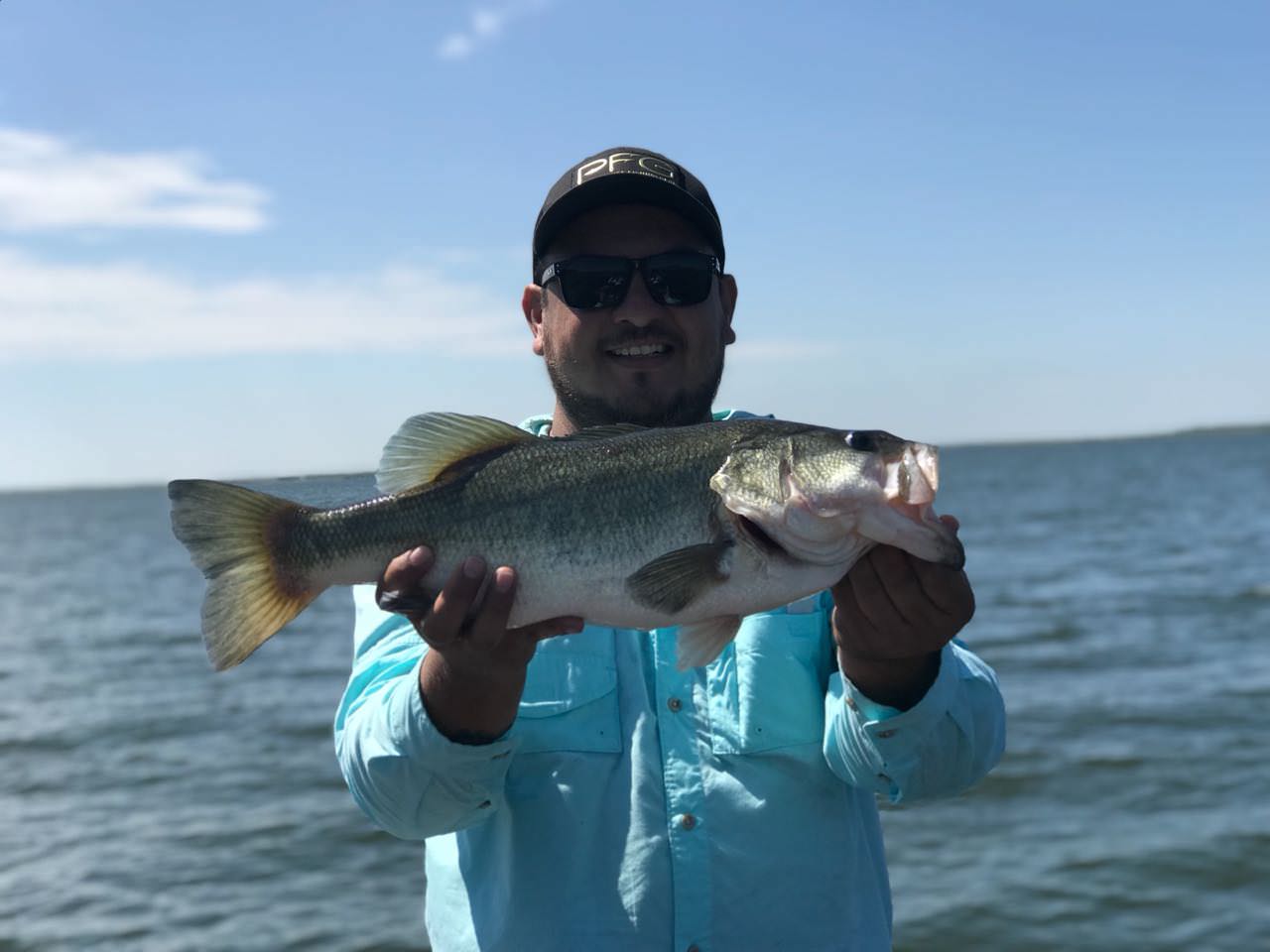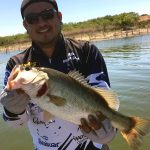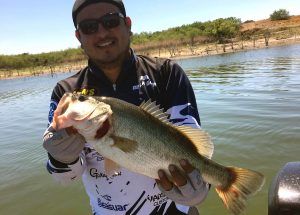
Bass jigs are an integral part of many Bass fishing techniques. With the right jiggling from the angler, they fool the fish into thinking they are getting the drop on an unsuspecting snack.
If you really wants to catch a Bass, you are going to have to be a little sneaky about things. Bass prefer to eat live fish, and may ignore lifeless-looking prey. Jigs that appear to be fish are more likely to invite an aggressive attack from a Bass.
Many top techniques revolve around using both a Bass jig and a trailer, which is attached to the main jig. This setup creates “legs” and makes the jig look more like a crayfish. This is usually best done in areas where there is some cover. Bass like to hang out in shade to ambush their prey, so having cover makes them feel safer about striking.
The art of fishing is much more interesting if you can actually catch something, so it makes sense to opt for what works!
Most Bass fishermen have Bass jigs in their kit.
When you really want to catch something, you need to fool the fish. Jigs are perfect for this! With Bass jigs, you will need to practice the various Bass fishing techniques to get the best results. Most fishermen take a few years to perfect their skills. After all, it takes a delicate touch to make the Bass jigs dance and flit through the water like a live fish.
Why do Bass jigs work and what are some of the best Bass Jigs available?
The best Bass jigs work because they resemble what Bass recognize and prefer to eat. Crayfish are always popular snacks for Bass, both largemouth and smallmouth. Bass jigs that resemble crayfish in color, configuration and action are generally a good choice.
Sugar Lake Bass also enjoy baitfish, frogs, spiders and other small lake creatures. There are several classes of jigs that imitate baitfish. Both classes of Bass jigs can be dressed with pork rinds or eel streamers to further enhance their effectiveness.
Unfortunately, there are no guarantees in Bass fishing. Temperature, water clarity, fishing pressure, time of the year and all sorts of other variables make it impossible to identify a “best Bass jig” which will work everytime. There’s no lure out that that will work anywhere, anytime, in any water with both large and smallmouth Bass.
The Booyah Boo Bass Jig is always a good choice. It is available in a variety of colors and sizes and it imitates a crayfish. Most Bass will strike it on the fall and it is important to keep your line taught so that you do not miss the strike. It will be a soft “pull”, usually.
While Bass will hit a spinner bait or plug bait hard, the strike on a jig is subtle and easy to miss. The Bass fishing techniques to use will vary according to the Bass jig you use, so choosing and learning to use the your Bass jig of choice is crucial.
With a Bass jig, you must take your time retrieving the jig if you don’t get a strike on the first fall. Twitch it and hop it slowly across the bottom. Bass jigs are comparatively snag resistant so do not be afraid to cast into structures like grass and weeds. If the lure hangs up, it can usually be twitched or hopped off and you will find that many big Bass like weeds and grass. Fish the points but do not forget the indentures, because they can be hot too.
In winter, when water temperatures are colder, slow your action down a bit and use smaller jigs. The Booyah is not the only good jig. The granddaddy of all jigs is the Arkie Bucktail. It is comparable to the Booyah in its action and characteristics. The Chompers Skirted Football Jig and Uncle Buck’s Best Bass Jig also fall into the category of great jigs that resemble crayfish.
The best Bass jigs to use to mimic baitfish are the Strike King Swim Jig, the Monsoor Swim Jig and Bass Pro’s Enticer. These lures can be more effective in streams than still waters. In addition, if you have run into the rare Bass that does not like crayfish, these lures can be a winning alternative.
The best fishing strategy is to have both types of Bass jigs available until you learn the particular waters you are fishing. It is the Bass who determine the best Bass jigs and they are known to change their minds a lot. Keep experimenting and stay one step ahead of the fish.
Types of Bass Jigs
If you plan to go Bass fishing, you need to make sure you are properly geared up, and have all the best fishing tackle—especially a few good Bass jigs. This is why it is so important to take the time to learn more about the different types of jigs and what each type has to offer.
One of the most commonly used types of Bass jigs is the finesse jig. This is one of the smaller jigs and works well when you want to fish in calm waters. These are best used in clear waters and they typically have a much smaller profile than other jigs for Bass fishing.
Use them to easily skip under docks or when you want your jig to stay on the surface of the water. Because of their light weight, they allow for a more subtle approach and can be fished around rocks effectively. They are quite easy to use and typically very effective at catching Bass.
There is also the football head jig style, which is a fairly new concept but one most fishermen are taking to quite quickly. Because the head of the jig is shaped like a football, you can easily fish it around on rocks without it getting snagged. You do not have to worry about it getting caught in between rocks as you do with other Bass jigs, because of the oblong design of the head. This shape prevents it from fitting into any cracks or crevices in between rocks.
Swimming jigs are relatively new in the sport of Bass fishing. However, this is now one of the most versatile types of jigs. You can speed it up or slow it down, and fish it around any type of cover or structure.
If you want to use the most effective Bass fishing techniques, you must have the proper Bass jigs. These are just a few of the best Bass jigs, which show how important texture and color are to catching Bass. It can take a bit of trial and error to test out different Bass jigs and see what works for you and what you could go without. At least by supplying yourself with the right Bass jigs, you stand the best chances of success on your next fishing adventure.
Bass Jig Fishing Techniques
Fishing with a jig is one of the easier fishing techniques to learn, however it is one of the more difficult to truly master or even become proficient. A jig can be fished 100 different ways and as long as it is in the water, there is a good chance that a fish will take interest and bite it. Jigs come in all different sizes with different characteristics designed for specific presentations or situations. The following jigs and associated presentations are some of the most popular styles of fishing a jig for largemouth Bass.
1. Flipping / Pitching Jig
- They have an arkie style head jig often
- Rubber or Silicon Skirt
- Use a plastic trailer like a Zoom Chunk or a Yamamoto twin tail grub -oz. oz. to 1 ½ oz. in weight with 3/8 oz and 1/2 oz as the most standard weight.
- Imitates a crayfish in heavy grass or wood cover
Technique: After the flipping jig hits the water, let it sink straight down. Lots of bites occur on the fall. Hop the bait up and down and slowly swim it out of the cover and back to the boat.
- Swimming a Jig
- Bullet shaped jig head – Rubber and silicon skirt combinations- often will have flash of silver, gold or bucktail hair
- Use a single tail grub for the trailer and make sure the tail is facing down
- 1/16 – ½oz in weight with a ¼ being the standard – Imitates a minnow, bream, or other local baitfish
Technique: Cast to likely targets or just beyond them and slowly swim the bait back to the boat.Try and hit the cover in the water like tree branches or docks to create a reaction.
3. Jig head with Worm or Darter head
- Can come in several styles generally slender and bullet shaped
- No jig skirt use a plastic worm Roboworms are excellent anywhere in the country
- Make sure the worm is placed on the hook straight so it does not spin
- Use as light of a weight when dragging a worm as you are comfortable with
Technique: Let the lure sink to the bottom and then slowly swim the lure back to the boat. When the bite is really tough keep constant contact with the bottom and move it slowly.
4. Football Head Dragging Jig
- Football style head jig is excellent in rocky lake bottom lakes for preventing snags
- Rubber and silicon skirt type jigs
- Use a twin tail grub or other typical jig trailers like creature baits, chunks, or beavers.
- ¼ – 1 ½ oz. with ½ and ¾ oz. being exceptional for this style of fishing
- Imitates a crawdad or bream moving along the rocks
Technique: Cast the lure to deeper ledges and rocky points and drag the lure along the bottom. Excellent bait choice in the winter and summer in lakes with lots of water deeper than 25 feet.
5. Swim Jig – Chatterbait Style
- Arkie and bullet head style jigs with metal blade that vibrates and shakes in the water
- Uses Silicone skirts
- Use whatever plastic lure you like a trailer from a worm to grub to even a small swim bait
- ¼ – 1 oz. with a ? and ½ oz. lure being the most popular – Imitates baitfish, minnows, crawdads all depending on the color choice and technique
Technique: Cast and retrieve the bait like you would a crank bait or a spinnerbait. Let the chatter bait sink all the way to the bottom and fish more like a jig for a big bite
6. Ball Head jig – Grub Swimming for Smallmouth
If you fish a lake that has small mouths in it, one of the most tried and true methods is swimming a grub. Use a small ball head jig with a spinning rod and a grub anywhere from 3–5 inches. Cast it out, let it sink to the desired depths and just start to slowly reel and hang on for some smallie fun. I like a white with some color flake in the plastic or a smoke colored grub for most times of the year. However, an occasional all-chartreuse grub also works.




No comment yet, add your voice below!